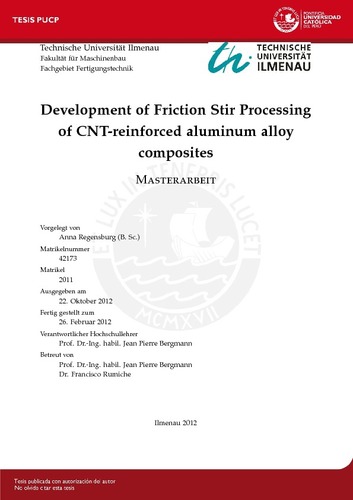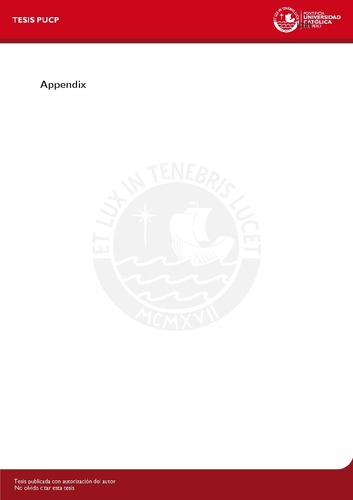| dc.contributor.advisor | Bergmann, Jean Pierre | |
| dc.contributor.advisor | Rumiche Zapata, Francisco Aurelio | |
| dc.contributor.author | Regensburg, Anna | es_ES |
| dc.date.accessioned | 2015-08-13T00:37:59Z | es_ES |
| dc.date.available | 2015-08-13T00:37:59Z | es_ES |
| dc.date.created | 2012 | es_ES |
| dc.date.issued | 2015-08-12 | es_ES |
| dc.identifier.uri | http://hdl.handle.net/20.500.12404/6225 | |
| dc.description.abstract | Owing their wide range of exceptional properties, for example thermal conductivity values of
more than 3000W/(mK) and strength in the range of 100 GPa, Carbon Nanotubes (CNTs) have
recently gained much attention as reinforcement for composite materials.
Considering the practical application in metal matrix composites (MMCs), tranferring those
favourable properties from nano to macro scale represents a main challenge. Methods of the
powder metallurgy route show promising results so far, but also lead to long process times and
damage of the tublar structure of the CNTs due to prolonged ball milling times.
At this point, the application of Friction Stir Processing (FSP) for fabricating CNT-reinforced
MMCs offers the possibility to reduce process times and realize the required reinforcement at
the relevant location of the component. The process uses a specially designed tool with a pin to
plasticize the base material by frictional heating and thus incorporate the reinforcing material
by stirring it into the workpiece.
Investigations, that have been carried out on this subject, generally consider the unifom
dispersion of the CNTs within the matrix as the key challenge of this process. So far, the
solution herefore is the application of multipass-FSP in order to distribute the CNTs uniformly
by processing the weld up to five times with alternating welding direction. This method
usually leads to damage or even destruction of the tubular structure of the CNTs. Regarding
all investigations on this subject, it can be noticed, that only conventional tool profiles like
cylindrical or threaded were used for the experiments, though other profiles like square
or more complex ones are considered to exhibit an increased mixing effect. Therefore the
objective of the thesis is to analyse the performance of four different tool geometries under
varying parameters and their influence on the CNT dispersion and general MMC composite
properties. Channels were cut into an Al 5086 plate, filled with CNT-powder and processed
by the different tools. The results were evaluated by metallographic analysis, hardness and
electrical resistance measurement and SEM analysis. Among the different geometries, the
triangular profile produced defect-free welds over the whole parameter set and distributed the
CNTs uniformly along a wide area close to the weld surface. | es_ES |
| dc.description.uri | Tesis | es_ES |
| dc.language.iso | eng | es_ES |
| dc.publisher | Pontificia Universidad Católica del Perú | es_ES |
| dc.rights | info:eu-repo/semantics/openAccess | es_ES |
| dc.rights.uri | http://creativecommons.org/licenses/by-nc-nd/2.5/pe/ | * |
| dc.subject | Soldadura | es_ES |
| dc.subject | Aluminio--Soldadura | es_ES |
| dc.title | Development of friction stir processing of CNT - reinforced aluminum alloy composites | es_ES |
| dc.type | info:eu-repo/semantics/masterThesis | es_ES |
| thesis.degree.name | Maestro en Ingeniería Mecánica | es_ES |
| thesis.degree.level | Maestría | es_ES |
| thesis.degree.grantor | Pontificia Universidad Católica del Perú. Escuela de Posgrado | es_ES |
| thesis.degree.discipline | Ingeniería Mecánica | es_ES |
| renati.discipline | 713347 | es_ES |
| renati.level | https://purl.org/pe-repo/renati/level#maestro | es_ES |
| renati.type | http://purl.org/pe-repo/renati/type#tesis | es_ES |
| dc.publisher.country | PE | es_ES |
| dc.subject.ocde | https://purl.org/pe-repo/ocde/ford#2.03.01 | es_ES |







